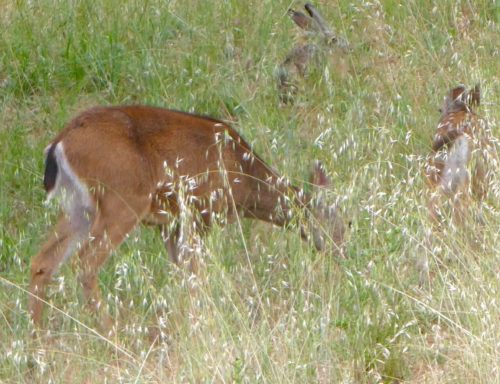Folks in several West Marin towns today stepped forward to aid victims of two of the 16 massive fires blazing 30 to 50 or more miles away. The Dance Palace Community Center in Point Reyes Station and the San Geronimo Valley Cultural Center are providing shelters for tonight, as is Marconi Conference Center in Marshall. Lawson’s Landing in Dillon Beach is providing campsites while the Presbyterian church in Tomales is providing food.
West Marin School’s gym cannot be used as a shelter, as many had expected. School is in session, and the gym is needed because there is so much smoke in the air children cannot safely take recess outdoors. At the same time, numerous West Marin residents have offered the evacuees a bed. All told, more than 200 evacuees from Sonoma and Napa counties are receiving a night’s lodging in West Marin.

The Dance Palace Community Center, as did the others, provided food. It also offered clothing to evacuees. Since the majority are Spanish speaking, bilingual local volunteers have been assisting as translators. Other West Marin residents have told evacuees they can stay in their homes.
In Sonoma County, the Sheriff’s Office reported, seven people [later revised to 42] are known to have lost their lives to the fires, and hundreds more are unaccounted for. In Napa County, at least two lives have been lost. The fires have also destroyed more than 5,700 homes and businesses in the two counties. Eight people have died in Mendocino County fires, and three have perished from fire in Yuba County.
At midday today (Monday), the California Department of Fire and Fire Protection reported that in neighboring Sonoma County: 1,500 acres were burning at Highway 37 and Lakeville Highway; 5,000 acres were burning north of Glen Ellen; and 1,000 acres were burning in Geyserville.
In nearby Napa County, Cal Fire also noted, fires that are still spreading had by mid-afternoon burned: 25,000 acres in Calistoga; 25,000 acres south of Lake Berryessa, and 3,000 acres west of the City of Napa.
 Smoky sunrise. When I awoke this morning, the smell of smoke was in the air, and the rising sun glowing through the haze formed a red disk on the horizon. (Photo by Lynn Axelrod)
Smoky sunrise. When I awoke this morning, the smell of smoke was in the air, and the rising sun glowing through the haze formed a red disk on the horizon. (Photo by Lynn Axelrod)
My fiancée Lynn is coordinator of the Point Reyes Disaster Council, and although today’s fires aren’t technically Point Reyes disasters, she soon began getting phone calls from people wanting to know if shelters would be opened here? Where would supplies come from? Lynn has ended up spending her day as an intermediary between various organizations, numerous volunteers, and people staffing shelters at the Dance Palace Community Center and at Marconi Conference Center.
In the midst of all this, I set off for Kaiser in San Rafael where my new eye glasses were ready to be picked up. However, before I left town, I dropped off Lynn’s mail at the postoffice, which turned out to be closed for Columbus Day. The detour, however, let me see an unexpected mass of cars and trucks jamming Point Reyes Station. There were so many that Green Bridge Gas & Auto, the only gas station in the area, had run out of gasoline.
 Volunteering at the Dance Palace, where West Marin residents donated piles of clothing for survivors of the fires. Some evacuees had lost much of what they owned.
Volunteering at the Dance Palace, where West Marin residents donated piles of clothing for survivors of the fires. Some evacuees had lost much of what they owned.
One of West Marin’s many wonderful qualities is how quickly community members volunteer to help when there’s almost any kind of dire need. Wearing my new eyeglass lenses while driving home, I began checking the passing scene and soon noticed another group of volunteers. A series of horse trailers was heading east on the Point Reyes-Petaluma Road. I’ll bet those folks are en route to helping evacuate horses, I thought.
As it happened, not long after I got home, Marin County Fire Chief Jason Weber called to speak with Lynn about a Disaster Council matter. I gave him her cell phone number, and while I had him on the line, I used the opportunity to ask about all the horse trailers. The chief said they’d probably be used to evacuate not just horses but other large animals as well. Mystery solved.
The Marin County Fire Department from the start was well represented on the front lines. The county reported dispatching 22 engines, 5 ambulances, 3 “chief officers,” 1 bulldozer, 1 hand crew, and 7 special firefighters to help neighboring fire departments. Eventually, almost 8,000 firefighters from all over were attacking the blazes, along with 550 firetrucks (including 170 from out of state), 73 helicopters, and more than 30 airplanes.
Meanwhile over at Civic Center, the Marin Sheriff’s Office and the Red Cross have opened a shelter in the Veterans’ Auditorium and report having served meals to 675 evacuees. Terra Linda High School has opened a shelter to house 49 people. Altogether, Marin County is sheltering at least 2,000 evacuees.

Olema Hill, Sept. 21. Nor is West Marin invulnerable to wildfires, having survived five in the past month alone. Thankfully, all of those were contained before they could do much damage. This fire was limited to eight acres. (Photo by Richard Dillman)
Still to be determined is why more than a dozen major fires broke out around the same time Sunday night in Sonoma, Napa, and Mendocino counties. One hypothesis blames a combination of dry vegetation and high winds that damaged power lines and spread the resulting fires rapidly. Fire officials are investigating.
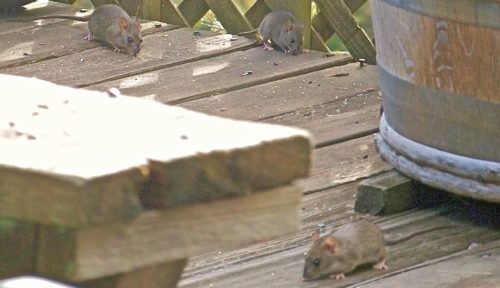












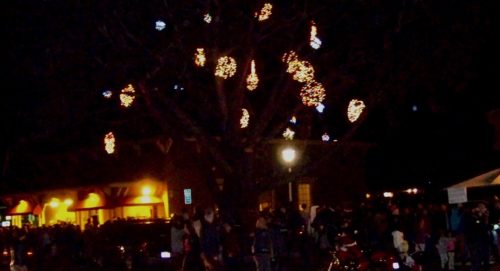



 As of Wednesday, the “stump” of the former town Christmas tree had been lightly decorated with prayer flags. Until the stump is removed, other decorations can be expected, one of the Wells Fargo staff told me.
As of Wednesday, the “stump” of the former town Christmas tree had been lightly decorated with prayer flags. Until the stump is removed, other decorations can be expected, one of the Wells Fargo staff told me.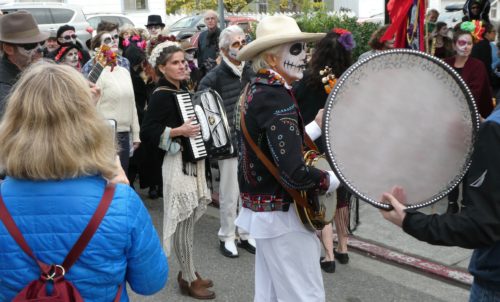




 At the firehouse, firefighters cooked a variety of pancakes (regular, vegetarian, or gluten free), sausages and eggs, which they served along with milk, orange juice and coffee. Seen frying sausages is Ken Eichstaedt, manager of Inverness Public Utility District; the district administers Inverness Volunteer Fire Department’s finances.
At the firehouse, firefighters cooked a variety of pancakes (regular, vegetarian, or gluten free), sausages and eggs, which they served along with milk, orange juice and coffee. Seen frying sausages is Ken Eichstaedt, manager of Inverness Public Utility District; the district administers Inverness Volunteer Fire Department’s finances. Approximately 400 people showed up for breakfast in the firetrucks’ garage.
Approximately 400 people showed up for breakfast in the firetrucks’ garage.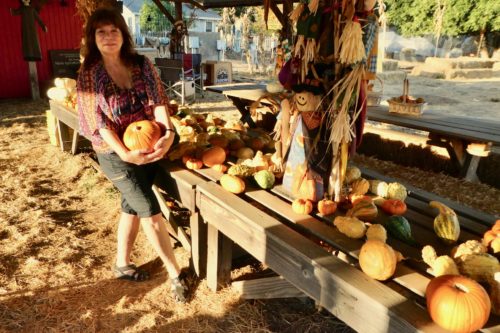




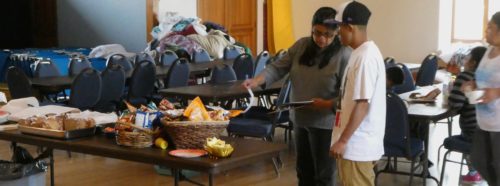
 Smoky sunrise. When I awoke this morning, the smell of smoke was in the air, and the rising sun glowing through the haze formed a red disk on the horizon. (Photo by Lynn Axelrod)
Smoky sunrise. When I awoke this morning, the smell of smoke was in the air, and the rising sun glowing through the haze formed a red disk on the horizon. (Photo by Lynn Axelrod) Volunteering at the Dance Palace, where West Marin residents donated piles of clothing for survivors of the fires. Some evacuees had lost much of what they owned.
Volunteering at the Dance Palace, where West Marin residents donated piles of clothing for survivors of the fires. Some evacuees had lost much of what they owned.








